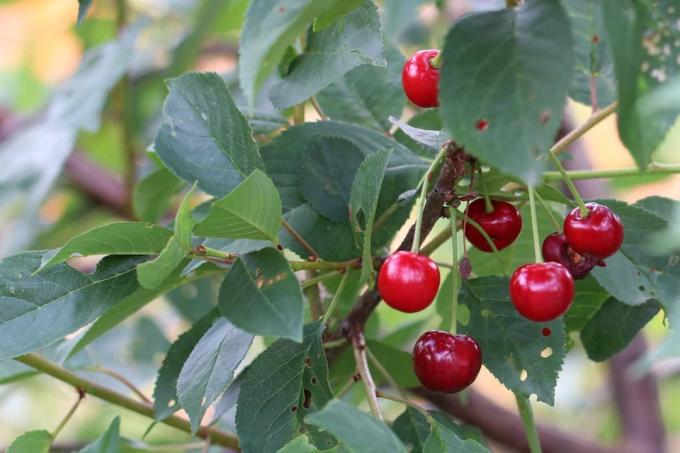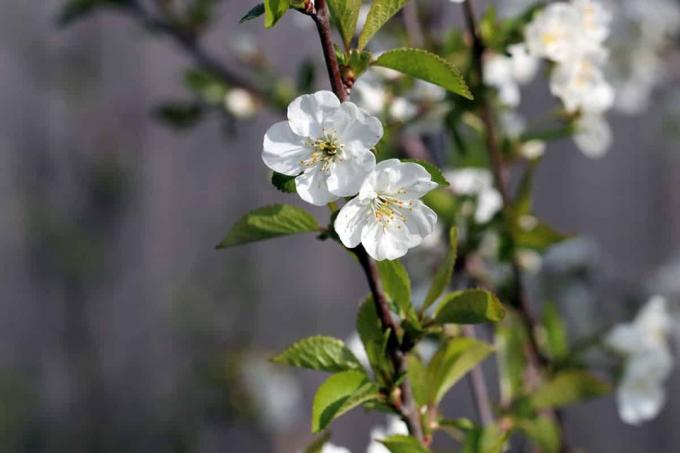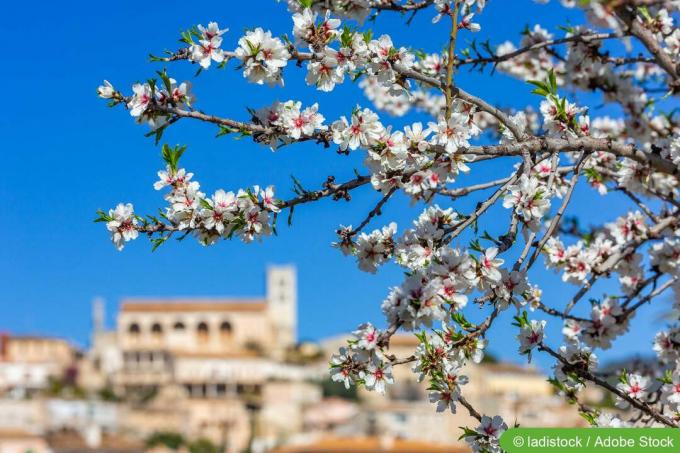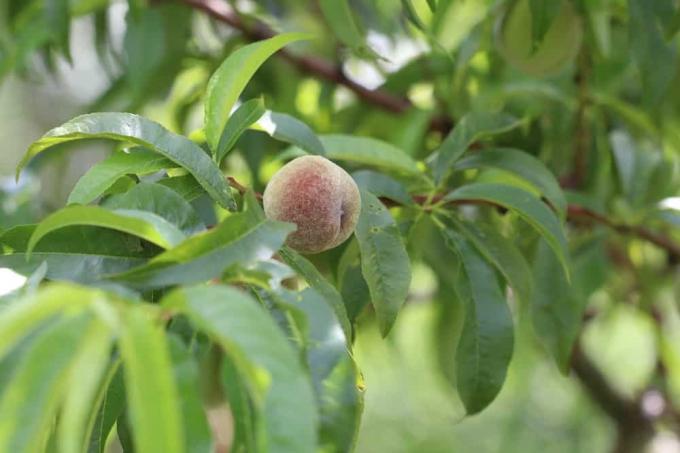

Table of contents
- education cut
- timing and frequency
- Tips for morello cherries
- Sweet Vistula
- taper cut
- Pruning diseased sour cherry tree
If you want to harvest a lot of sour cherries in summer, you have to take good care of your sour cherry tree. This includes skillful pruning after harvest. When which shoots the scissors have to see depends on whether it is a sweet sour cherry or a morello cherry.
education cut
In the first few years after planting, a framework is built up from a center and about four shoots. Scaffold drive extensions are shortened by half in the first five years. Wild shoots are completely removed in summer. The sour cherry can also be grown as a shrub. Sour cherries, on the other hand, are less suitable as trellis trees.
timing and frequency
Tart cherries generally set their flower buds in the previous year. Therefore, all varieties have in common that the pruning should be done immediately after harvest. This will encourage this year's bud formation. The cutting day should be cloudy but dry. The distances between two pruning measures and which shoots are shortened and how. must be removed, however, depends on which sour cherry group the variety belongs to.
A distinction is made between sweet sour cherries and morello cherries.
Morello cherry
Morello cherries like the varieties 'Gerema' or 'Morellenfeuer' only bear fruit on one-year-old wood. These are shoots that sprout last year. After the harvest, these long shoots wilt and form only short new shoots at the ends. In the following year, these new shoots will only have a small amount of buds. They also tend to droop a lot. To prevent this from happening, every tree needs a strong pruning every year to form new fruit wood.
Sweet Vistula
Sweet sour cherries like the varieties 'Koroser Weichsel' or 'Heimanns Rubinenweichsel' bear fruit on one-year-old but also on two- and three-year-old shoots. They do not age as quickly as with the morello cherry. Sweet Vistula are therefore only thinned out every two to three years.
Tips for morello cherries
Implementing the following tips will help you get the most out of every cut. In the case of the sour cherry tree, it means in plain language: an even richer harvest!

1. Cut as early as possible
After the harvest, you theoretically have a few weeks to carry out the necessary pruning measures. But don't delay the cut too long. The sooner you grab the scissors, the stronger the regrowing shoots will be. This promises a more lush cherry harvest.
2. Thin out vigorously
Prune most of the harvested long shoots, called whip shoots. Only a quarter of the original length should remain of them.
3. Redirect to new growth
When shortening, direct each long shoot, if possible, to a freshly sprouted side branch. To do this, place the scissors just above the new growth. Under no circumstances should you prune the new growth itself.
4. Thin out excess shoots
Make sure that no more than three 20-25 cm long annual shoots remain for every 10 cm of leading branch length. Surplus shoots should be completely removed. To do this, select the weakest or most unfavorable growing shoots.
5. Correct steep shoots
Vertical shoots do not bloom. Removing them with scissors isn't the only solution. Especially if there are a lot of such shoots on the sour cherry tree, there would hardly be anything left of it after pruning.
- Increase the angle to the master
- Use spreaders, weights or cords
- 60° angle is ideal
- act early
- the younger the branch, the more pliable it is
6. Combine harvest and pruning
Since almost every fruit shoot of the current year has to be shortened anyway with the morello cherry, you can combine pruning with the harvest. Separate whole fruit-laden branches as needed instead of picking tart cherries for tart cherries. So after the end of the harvest season there is little left to do.
7. Pull up guide branches
Would you like to prevent the branches from drooping and the crown of your sour cherry from resembling a weeping willow? Then pull leading branches out of a few long shoots. Instead of removing three quarters of the length, cut where new branching is welcome.
8. Ensure good exposure
Over time, the crown of the sour cherry can be so dense that individual branches shade each other. Then you should not only shorten harvested shoots, but also prune perennial branches. This also continuously rejuvenates the crown.
- not every year, only thin out when necessary
- Shorten some thicker branches
- select the interface specifically
- always above the beginning of a younger shoot
- if not possible, cut to astring
In order to select exactly the right branches, you should look at the sour cherry tree from all sides from time to time. In this way you ensure that a harmonious crown structure is retained.

Sweet Vistula
With the sour cherries you will not experience the problem with bald whip shoots. But their fruit wood will be exhausted after three to four years and will no longer bear fruit. That is why regular new growth must also be ensured for them, while worn-out fruit wood has to disappear from the tree.
1. Thin out disturbing shoots
First remove all dead and weak shoots. After that, all branches that grow unfavorably inward must be removed.
2. Shorten shoots that are too long
You should shorten fruit shoots that are still usable but very long. This promotes even more new fruit wood in the form of many short shoots.
3. Cut only older fruit wood
Since all shoots in this group can bear many fruits for up to three years, they should also be given the opportunity to do so. It means less pruning for you, as you mainly have to prune the three-year-old branches.
4. Divert to younger shoot
Do not completely remove aged fruit wood. Redirect it instead. It does not have to be a new shoot like the morello cherry.
- redirect to a younger shoot in the rear area
- this can be a one or two year shoot
- cut off the old branch just above it
5. Cut back shoots to tenons
Steep shoots are annoying and do not bear fruit. In the case of the sour cherry, it is best to cut them back to cones. This also applies to disruptive competitive instincts.
taper cut
Both morello cherries and sweet sour cherries can become very old if the maintenance cuts are left out for a long time. Such a sour cherry tree is then very heavily branched. Only a little light penetrates the interior of the crown through the resulting network of branches, and it becomes bare. Delicious-tasting sour cherries are becoming scarce. Since the sour cherry tolerates pruning, there is no need to abandon such a tree. A strong pruning must be done in the period from October to the end of February. If the tree is very old, the pruning measures may have to be spread over 2-3 years.
- cut dead wood on a ring or saw
- strongly branched, hanging branches
- a young side shoot at the base is ideal

Tip:
If an aged branch cannot be redirected to a young side shoot, you may prune it back to a 10-15 cm spigot. Choose two strong, slanting horizontal new shoots the following summer. Remove the remaining shoots and the dried cone.
Pruning diseased sour cherry tree
Regular pruning is also there to prevent diseases like the dreaded Monilia peak drought. If she has conquered the sour cherry tree anyway, all affected branches must be removed and disposed of as residual waste. These pruning measures cannot be postponed until the harvest is over.
Tip:
To minimize the risk of transmitting dangerous pathogens, you should disinfect the cutting tool used before and after each cutting. It should also have sharp blades to make smooth cuts.
 garden editorial
garden editorial I write about everything that interests me in my garden.
Learn more about fruit trees

Life on Mallorca: highlight almond blossom
Life on Mallorca offers a lot more than sun, summer, beach and Ballermann. The beginning of the year on the popular holiday island is all about blossoming almond trees. We'll tell you when and where you can best enjoy the almond blossom on Mallorca.

Is the ornamental peach edible? | 15 tips for care and cutting
The ornamental peach can be a decorative addition to the garden as early as March, when the trees, which are up to three meters high, are in bloom. Here we tell you how to look after them and whether their fruits are edible.

20 old apple varieties | List of old apples in & around Germany
Hardly any type of fruit is as diverse as the apple. The number of apple varieties worldwide is estimated at over 20,000. Old apple varieties are those that were discovered before 1950. We have compiled a list of popular, old varieties for you.

Peach Tree Diseases: Leaves curl or turn yellow
Among the fruit trees, the peach tree is one of the most susceptible to diseases. It often has to contend with fungal diseases such as curling disease. Here you can find out which other tree diseases can affect it, how to recognize them and how to fight them successfully.

Half-trunk cherry and apple trees: planting distance and care
Fruit trees definitely belong in every garden. But what to do if the garden is too small for a large tree? Then trees that were grown as half-stems can help. They take up less space, but deliver lots of fruit. More about this here.

Pruning a peach tree: instructions | Keeping in the pot & diseases
If there is no garden available, but you can still enjoy delicious peaches from your own cultivation should, then the peach tree can also be cultivated in a bucket and placed on the balcony or terrace become. However, care is somewhat different here than with peach trees cultivated outdoors.


